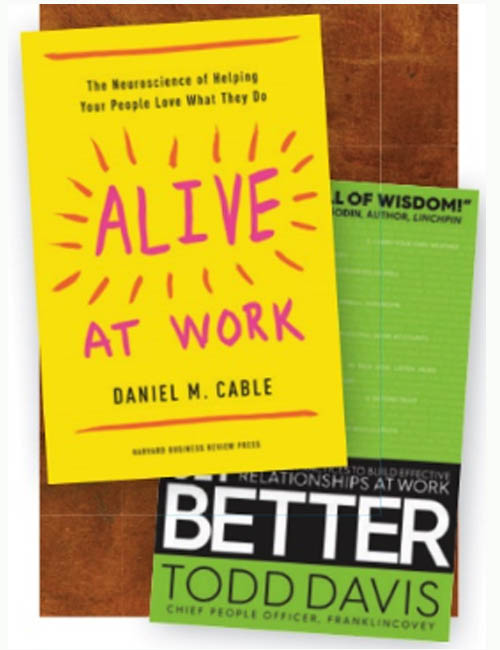Reviewed by Pat Sabena, Sabena Qualitative Research
Fairfield, CT, psabena@qual.com
Get Better: 15 Proven Practices to Build Effective Relationships at Work
by Todd Davis, Simon & Schuster, 2017
Alive at Work: The Neuroscience of Helping Your People Love What They Do
by Daniel M. Cable, Harvard Business Review Press, 2018
I paired these two books in one review because they both aim to help people have happier and more productive relationships in their corporate jobs. While it may seem somewhat ironic that a solo practitioner for over 50 years is reviewing these books, both books did provide interesting insights and helpful suggestions of people and work dynamics that I could apply to my practice, even as someone who works contently alone in her home office.
The first book is Get Better by Todd Davis, the chief people officer at Franklin/Covey, a global company specializing in performance improvement. Davis asserts that the nature of the relationships between people is the most significant driver of professional and personal effectiveness. In the end, he insists, it’s the relationships that create the culture that becomes an organization’s ultimate competitive advantage. Davis’ writing is clear and amusing, filled with actual stories and end-chapter summaries of its key points.
Among Davis’ 15 clear and actionable practices for improving relationships at work, seven of them resonated most strongly with me: Carry Your Own Weather; See the Tree, Not Just the Seedling; Think We, Not Me; Examine Your Real Motives; Talk Less, Listen More; Extend Trust; and Make It Safe to Tell the Truth.
In the feast-or-famine commoditizing of today’s world of qualitative research, all 15 of these practices feel not only applicable but also essential and achievable. Qualitative researchers can be the bearers of bad news: the concepts are off message; the brand identity is weak; the campaign is misconstrued; the product doesn’t fill or create a need.
In the Extend Trust chapter of Get Better the author quotes Abraham Lincoln as saying, “If you trust, you will be disappointed occasionally, but if you mistrust, you will be miserable all the time.” Trusting the client to receive and welcome bad news to avoid future disaster is a risk, but one that we must take to stay true to ourselves in presenting the deep and heartfelt perceptions of our respondents. That’s where the chapter on Make It Safe to Tell the Truth comes in. Building trust and rapport with a client allows two-way feedback that encourages us to stand behind our research even when the news is not what the client hoped to hear. It also prompts strong and astute recommendations on our part on how the client can fix the problem(s) revealed in the research.
The second book, by Daniel M. Cable, a social psychologist who is ranked among the top 25 most influential management scholars in the world, has a title that makes my heart sing. It’s called Alive at Work. I have always proclaimed to anyone who would listen that qualitative researchers have the best job in the world. Encouraging people to dig deep to tell their stories, while we really listen to them, and take their message to others who will change things for the better… what could be more exciting than that?
This book testifies that someone is listening to the fact that many people hate what they do for a living and dread getting up to start their work week. That is living a soul-less existence. Cable explains that the cause of all this unhappiness is actually biological. He maintains that “organizations, in an effort to routinize work and establish clear-cut performance metrics, are suppressing…the part of our brains that craves exploration and learning, and that gives us hits of dopamine when we follow its urges.” He calls this exciting process of the brain the “Seeking System.”
Cable’s book goes on with insight-producing quizzes and many fascinating anecdotes of how individuals and small groups of people all over the world managed to turn themselves and their employees into positive forces for legacy, leadership and purpose. After all, it is difficult to inspire others when you are not feeling inspired. Through promoting self-expression and encouraging experimentation, such leadership can help employees experience the impact of their work, and craft narratives about the purpose of the work they do.
Consider that it is possible to go from mind-numbing monotony to the meaningful joy of work well done. That is the premise and the practice and the potential for broader success of Alive at Work. If you know anyone who is caught in this corporate or non-corporate mind-sucking situation, buy this book, read it first, and then hand it on.


Be the first to comment